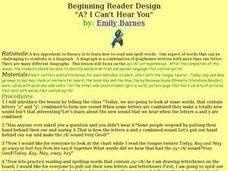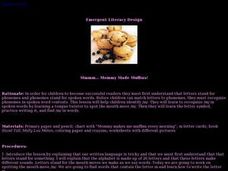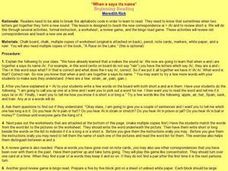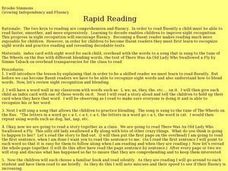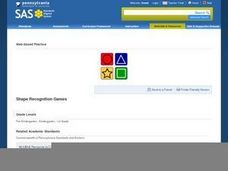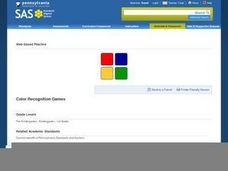Curated OER
U-u-under The U-u-umbrella!
Students practice using phonemes because they need to be able to recognize that phonemes and letters correspond with each other in order to become a proficient reader. The practice is done using the letter "u".
Curated OER
Yummy in My Tummy
Students explore phonemes in spoken words. They discuss the correspondence u=/u/. Students identify a meaningful representation for the phoneme and practice identifying /u/ in both written and spoken words. Students learn a tongue...
Curated OER
Champions Check
First graders identify consonant digraphs in written and spoken language. After a brief discussion of the combinations of /c/ and /h/ that comprise the /ch/ digraph, 1st graders practice identifying initial and final placement of the...
Curated OER
Ehhh! Can you repeat that!
Students assess how to recognize phonemes that stand for letters creating spoken words utilizing the short vowel /e/. They associate our written language as a secret code to solve. The tongue twister "Everybody saw Eddie and the Eskimo...
Curated OER
A? I Can't Hear You
Learners identify the digraphs in written and spoken language. After a brief discussion on the combinations of letters that comprise digraphs, students practice a tongue twister containing the digraph ay. They identify the digraph in...
Curated OER
Chocolate Chicken
Students identify digraphs in written and spoken language. After a brief discussion on the combinations of letters that comprise digraphs, students practice identifying initial and final placement of the digraph /ch/ in words and tongue...
Curated OER
Aaaa! The Baby is Crying!
Learners discover the correlation between graphemes and phonemes. They distinguish phonemes in verbal word contexts and match the letters to the phonemes. They focus on working to recognize the phoneme /a/ in its oral and written form.
Curated OER
Reading Recall
Second graders review the vowe-consonant-e pattern in association with reading fluently. After identifying the changes made to a phoneme when the letter e is added at the end of the word, 2nd graders practice reading a phonetically...
Curated OER
Buzzing Bees
First graders engage in a instructional activity on phonemic awareness. They practice skills that are considered essential for good reading to occur. The skills of letter recognition and corresponding the letter to its phoneme are taught.
Curated OER
Mmmm...Mommy Made Muffins!
Students explore phonemes. They explore phonemes in spoken word contexts. Students discuss the phoneme /m/. They learn a tongue twister to help them recognize /m/. Students read "Stand Tall, Molly Lou Melon and identify the phoneme /m/...
Curated OER
A Tisket-A-Tasket, Let?s Make a Flower Basket!!!
First graders practice blending words with the phonemes /i/ and /e/. Working with a specific groups of letters, 1st graders create words using the vowels i and e. they decode those words and read them repeatedly to increase fluency.
Curated OER
When A Says Its Name
Students are introduced to the concept of vowel digraphs. They identify the digraph /ai/ in spoken language. After a brief discussion, students apply the rule for reading and spelling words containing the /ai/ digraph by playing word bingo.
Curated OER
Ta-Ta- Timer
Students identify a letter of the alphabet. They recognize this letter in print and in spoken language. The letter and phoneme chosen is the letter t and /t/. They write the letter in both lower and upper case. They read 'One Tiny...
Curated OER
Clapping Syllables
Learners explain that words are made up of parts called syllables. They associate spoken language with written words
Curated OER
Rapid Reading
Students review sight recognition and blending by using an index card with one of the words from the word wall on it. They read a story aloud as a class and hold up their card when they hear their word and sing a song that allows them to...
BBC
Lug and the Giant Stork - Capital Letters
Capital letters are the star of the show in a wonderful language arts lesson. After a teacher-led demonstration and discussion on capital letters, groups of pupils get together and work on the computer to fix the flashing letters that...
Curated OER
Identify Base Words and Suffixes to Read Multisyllabic Words #1
Show your scholars how adding an affix changes the entire meaning of a word; they focus on the suffix -able. You'll find a complete script here, but if you don't want to read this verbatim, use it simply as an outline. Learners...
Curated OER
Number Recognition Games
Students explore number sense by participating in a math recognition activity. For this number identification lesson, students practice pronouncing names of numbers and matching the number with an amount of objects. Students practice...
Curated OER
Shape Recognition Games
Students explore shapes. In this math activity, students identify basic geometric shapes. Students complete activities in which they identify shapes, symbols and letters. Students draw geometric shapes.
Curated OER
Word Recognition
Students recognize and spell color and shape words. In this color and shape words lesson plan, students reinforce their vocabulary and spelling skills.
Curated OER
Reading in Preschool
Students read along with their parents to promote their own reading and fluency. In this reading lesson plan, students look at picture books and follow along with their finger.
Curated OER
A Seed for All Needs
Students identify uses for plants. For this agricultural lesson, students read the book Spring Gardening and distinguish between food plants and flowers. Students plant flower in cups as a follow-up activity.
Pennsylvania Department of Education
Writing with Beans
Students become familiar with the letters in a word by pasting beans on it. For this Bean writing lesson, students make words using navy beans. Students color or paint the beans.
Curated OER
Color Recognition Game
Students study color words. For this math lesson, students complete a variety of activities on the computer in which they identify colors and color words.




